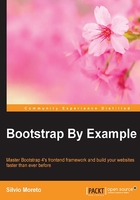
Understanding the grid system
The basis of the Bootstrap framework relies in its grid system. Bootstrap offers components that allow us to structure a website in a responsive grid layout.
To exemplify this, imagine an electronic square sheet table that can be pided into many rows and columns, as shown in the following screenshot. In the table, you can create as many lines as you want while merging cells. But what would happen if you wanted to change the layout of a single row? That could be painful.

The Bootstrap grid system works in a different way. By letting you define a set of rows, each one having a set of independent columns, it allows you to build a solid grid system for your web page. Also, each column can have different sizes to perfectly fit your template.
This not being enough, the Bootstrap grid system adapts for every viewport and resolution, which we call responsiveness.
To start learning about the grid system, we will introduce it using the example of a landing page. As you will see, Bootstrap will allow us to create a complete scaffolding that will automatically adjust the content for any viewport.